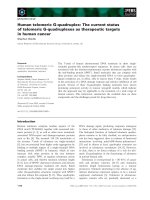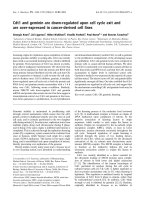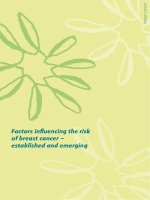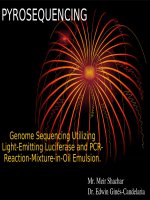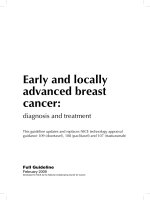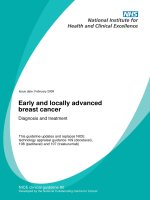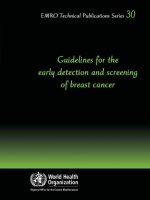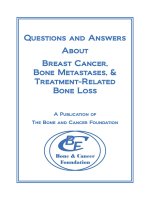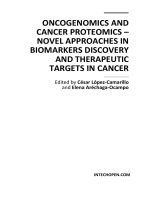Antioxydation and cell migration genes are identified as potential therapeutic targets in basal-like and BRCA1 mutated breast cancer cell lines
Bạn đang xem bản rút gọn của tài liệu. Xem và tải ngay bản đầy đủ của tài liệu tại đây (1.1 MB, 13 trang )
Int. J. Med. Sci. 2018, Vol. 15
Ivyspring
International Publisher
46
International Journal of Medical Sciences
Research Paper
2018; 15(1): 46-58. doi: 10.7150/ijms.20508
Antioxydation And Cell Migration Genes Are Identified
as Potential Therapeutic Targets in Basal-Like and
BRCA1 Mutated Breast Cancer Cell Lines
Maud Privat1,2, Justine Rudewicz2, Nicolas Sonnier1,2,3, Christelle Tamisier2, Flora Ponelle-Chachuat1,2,
Yves-Jean Bignon1,2,3
1.
2.
3.
Université Clermont Auvergne, Centre Jean Perrin, INSERM, U1240 Imagerie Moléculaire et Stratégies Théranostiques, F-63000 Clermont Ferrand, France
Département d’Oncogénétique, Centre Jean Perrin, F-63000 Clermont Ferrand, France
Biological Resources Center BB-0033-00075, Centre Jean Perrin, F-63000 Clermont Ferrand, France
Corresponding author:
© Ivyspring International Publisher. This is an open access article distributed under the terms of the Creative Commons Attribution (CC BY-NC) license
( See for full terms and conditions.
Received: 2017.09.19; Accepted: 2017.10.11; Published: 2018.01.01
Abstract
Basal-like breast cancers are among the most aggressive cancers and effective targeted therapies are
still missing. In order to identify new therapeutic targets, we performed Methyl-Seq and RNA-Seq of
10 breast cancer cell lines with different phenotypes. We confirmed that breast cancer subtypes
cluster the RNA-Seq data but not the Methyl-Seq data. Basal-like tumor hypermethylated
phenotype was not confirmed in our study but RNA-Seq analysis allowed to identify 77 genes
significantly overexpressed in basal-like breast cancer cell lines. Among them, 48 were
overexpressed in triple negative breast cancers of TCGA data. Some molecular functions were
overrepresented in this candidate gene list. Genes involved in antioxydation, such as SOD1, MGST3
and PRDX or cadherin-binding genes, such as PFN1, ITGB1 and ANXA1, could thus be considered
as basal like breast cancer biomarkers. We then sought if these genes were linked to BRCA1, since
this gene is often inactivated in basal-like breast cancers. Nine genes were identified overexpressed
in both basal-like breast cancer cells and BRCA1 mutated cells. Amongst them, at least 3 genes code
for proteins implicated in epithelial cell migration and epithelial to mesenchymal transition (VIM,
ITGB1 and RhoA).
Our study provided several potential therapeutic targets for triple negative and BRCA1 mutated
breast cancers. It seems that migration and mesenchymal properties acquisition of basal-like breast
cancer cells is a key functional pathway in these tumors with a high metastatic potential.
Key words: Basal-like breast cancer, BRCA1, RNA-Seq, cell migration, antioxydation
Introduction
Basal like breast cancers (BLBC) represent
between 10 and 20% of breast cancers. They are
associated with an aggressive phenotype, high
histological grade, poor clinical behavior, and high
rates of relapse (1). This cancer subgroup is
characterized by lack of estrogen receptor (ER),
progesterone receptor (PR), and HER2 amplification
(TNBC: triple-negative breast cancers) with
expression of basal cytokeratins 5/6, 14, 17, epidermal
growth factor receptor (EGFR), and/or c-KIT.
Currently, BLBC lack any specific targeted therapy,
due to the fact that they do not express ER or HER2
and thus are typically refractory to endocrine therapy
and to trastuzumab, a humanized monoclonal
antibody that targets HER2.
The identification of new markers and
therapeutic targets is thus necessary for this bad
prognosis cancer type. First, BRCA1-associated BC are
mostly BLBC (2) and sporadic BLBC (occurring in
women without germline BRCA1 mutations) often
show dysfunction of the BRCA1 pathway. The
characteristics of hereditary BRCA1-associated BC
Int. J. Med. Sci. 2018, Vol. 15
47
found in sporadic BLBC cancers have thus been
termed «BRCA-ness» with potential clinical
implications (3). As BRCA1 pathway may be deficient
in BLBC, these tumors may respond to specific
therapeutic regimens, such as inhibitors of the poly
(ADP-ribose) polymerase (PARP) enzyme (4). Cells
deficient in BRCA1 have indeed a defect in the repair
of DNA double strand breaks which could make them
particularly sensitive to the chemotherapy drugs that
generate such breaks, such as inhibitors of PARP
enzyme. However, not all BLBC are associated with
BRCA1 inactivation.
Then, EGFR could represent a therapeutic target
as it is often overexpressed in BLBC. Recently, a phase
II clinical trial showed good results (57% of
pathological complete response) of panitumumab
combined with an anthracycline/taxane-based
chemotherapy in operable triple-negative breast
cancer (5). Nevertheless, this study highlighted
biological signatures correlated with treatment
response. Heterogeneity of triple negative breast
cancers requires subtyping in order to better identify
molecular-based therapy. In 2006 already, Neve et al.
separated BLBC cell lines in two subgroup (basal A
and basal B) with different invasive properties (6).
Lehmann et al. then identified 6 triple-negative breast
cancer subtypes including 2 basal-like (BL1 and BL2),
an immunomodulatory (IM), a mesenchymal (M), a
mesenchymal stem-like (MSL) and a luminal
androgen receptor (LAR) subtype (7).
All these subclassification of triple negative
breast cancers were identified by studying
transcriptomic profiles. Epigenetic modifications in
breast cells could also allow identifying characteristics
of these breast cancers. Roll et al. reported a
hypermethylator phenotype in BLBC, characterized
by methylation-dependent silencing of CEACAM6,
CDH1, CST6, ESR1, GNA11, MUC1, MYB, SCNN1A,
and TFF3 genes that are involved in a wide range of
neoplastic processes relating to tumors with poor
prognosis (8).
Our results of Methyl-Seq did not confirm this
hypermethylator phenotype but we could not identify
hypermethylated BLBC specific genes. On the other
hand the RNA-Seq data allowed us to identify
antioxidation and cell migration as specifically
activated pathways in basal-like breast cancer cells.
Materials and methods
Biological material
The main characteristics of the cell lines used are
presented in table 1. MDA-MB-231 and HCC1937
human breast cancer cell lines were purchased from
the American Type Culture Collection (Rockville,
MD, USA) and were grown in RPMI medium
supplemented with 10% foetal calf serum, 2 mM
L-glutamine and 20 μg/ml gentamicin. SUM149 and
SUM1315 human breast cancer cell lines were
obtained from Asterand (Hertfordshire, UK) and
grown in Ham’s F12 medium according to the
manufacturer’s instructions. SUM1315MO2 cells were
transfected with a pLXSN plasmid containing the
full-length BRCA1 cDNA using Fugene 6 transfection
reagent (Roche Molecular Biochemicals). Control cells
were transfected with the pLXSN empty vector. After
selection in 721.5 µM G418 (Sigma Aldrich), clones
were tested for BRCA1 expression by Western
blotting (9). All cell lines were grown at 37˚C in a
humidified atmosphere containing 5% CO2. All our
cell lines are stored and managed by the CJP
Biological Resources Center (BB-0033-00075).
Cell immunohistochemistry
Cells were fixed in Preservcyt solution
(Thinprep) and cytoblocks were prepared with
Shandon Cytoblock kit (Thermo Scientific). Hormone
receptors (ER and PR), HER2, EGFR and cytokeratin
status were studied as already described (5). The
immunostainings were scored semi-quantitatively by
an expert pathologist under a light upright
microscope.
Table 1. Main characteristics of the cell lines.
Cell line
Site of origin
Pathology
MCF10A
MCF7
T47D
MDA231
MDA436
HCC1937
SUM149
SUM1315
SUM1315-LXSN (SL)
SUM1315-BRCA1 (SB)
Normal breast
Pleural effusion
Pleural effusion
Pleural effusion
Pleural effusion
Primary tumor
Primary tumor
Skin metastasis
Skin metastasis
Skin metastasis
Fibrocystic
Adenocarcinoma
Adenocarcinoma
Adenocarcinoma
Adenocarcinoma
Infiltrating ductal carcinoma
Inflammatory breast carcinoma
Infiltarting ductal carcinoma
Infiltarting ductal carcinoma
Infiltarting ductal carcinoma
Molecular type
(6)
Basal B
Luminal
Luminal
Basal B
Basal B
Basal A
Basal B
Basal B
Basal B
Basal B
Triple negative
subtype (7)
MSL
MSL
BL1
BL2
-
BRCA1 status
TP53 status
Wild type
Wild type
Wild type
Wild type
5382insC
5396 + 1G>A
2288delT
185delAG
185delAG
185delAG +
sauvage
Wild Type
Wild Type
Missense mutation
Missense mutation
Nonsense mutation
Nonsense mutation
Missense mutation
Missense mutation
Missense mutation
Missense mutation
Int. J. Med. Sci. 2018, Vol. 15
Nucleic acid extraction
DNA extraction was performed using the
QIAamp DNA mini kit (Qiagen) for cell lines and the
QIAamp DNA micro kit (Qiagen) for tumors. RNA
extraction was performed using RNeasy mini kit
(Qiagen). The quantity and quality of the nucleic acids
obtained were measured spectrophotometrically at
260nm and 280nm. RNA were also checked on 2100
Bioanalyzer (Agilent Technologies).
RNA sequencing and data processing
First, mRNA were purified using Oligotex
mRNA mini kit (Qiagen). cDNA libraries were then
generated following the GS-FLX Titanium cDNA
Rapid Library Preparation Method Manual (Roche).
Finally, emPCR amplification and 454 sequencing
were performed according to the manufacturer’s
protocol (emPCR Amplification Manual– Lib-L LV
and Sequencing Method Manual-GS FLX Titanium
Series, Roche). RNA-Seq data are available in the
ArrayExpress database (www.ebi.ac.uk/arrayexpress
) under accession number E-MTAB-5465.
Sequence reads were aligned on the human
genome (hg19) with GS Reference Mapper software
(Roche) and mapped on the human exome using a
home-made software named AGSA. Data was then
normalized by calculating the ‘reads per kilo base per
million mapped reads’ (RPKM) for each gene. When
the RPKM value was below the threshold of 0.3, then
it was considered as background noise and replaced
by zero.
Validation of gene regulation by q-RT-PCR
Total RNAs were extracted from cell lines using
RNeasy mini kit (Qiagen) according to the
manufacturer’s protocol. Quality of RNAs was
checked using the 2100 BioAnalyzer (Agilent
Technologies). Five microgram RNA was then
reverse-transcribed
using
First-strand
cDNA
synthesis kit (GE Healthcare). Multiplex quantitative
RT-PCR was performed using a 7900HT Fast
Real-Time PCR System (Applied Biosystems).
Predesigned
and
validated
gene-specific
probe-based Taq-Man Gene Expression Assays were
used and relative gene expression was determined
using the comparative threshold cycle method.
Ribosomal 18S was chosen as the endogenous control
gene.
Methyl-DNA sequencing and data processing
First, DNA was fragmented by nebulization
during 1min30sec at 2.1 bar of nitrogen pressure.
After DNA purification using Qiaquick PCR
purification kit (Qiagen), methylated DNA was
captured using MethylCap kit (Diagenode) following
48
the supplier recommendations. Libraries were
generated using GS FLX Titanium Rapid Library
Preparation Kit (Roche). Finally, emPCR amplification
and 454 sequencing were performed according to the
manufacturer’s protocol (emPCR Amplification
Manual– Lib-L LV and Sequencing Method
Manual-GS FLX Titanium Series, Roche). Methyl-Seq
data are available in the ArrayExpress database
(www.ebi.ac.uk/arrayexpress)
under
accession
number E-MTAB-5468.
Sequence reads were aligned on the human
genome (hg19) with GS Reference Mapper software
(Roche) and mapped on the human proximal
promotors using a home-made software named
AGSA. Data was then normalized by calculating the
‘reads per million mapped reads’ (RPM) for each
gene. When the RPM value was below the threshold
of 0.3, then it was considered as background noise and
replaced by zero.
TCGA data analysis
Both clinical and RNA sequencing data (Illumina
HiSeq RNAseq Version 2 data) of invasive breast
cancers were downloaded from The Cancer Genome
Atlas (TCGA) database. A total of 449 patients with
information on ER, PR and HER2 status were selected
to compare the expression profiles of genes in the
respective tumors. 71 cases were found to have a
negative ER, PR end HER2 phenotype (i.e.,
triple-negative), whereas 371 cases were positive for
at least one of these receptors.
Statistical analysis
Statistical analysis of data was performed using
R software. Significant differences between cell line
groups were sought by Wilcoxon test. Statistical
overrepresentation test were performed using
PANTHER classification system (10). For TCGA data,
Student’s t-test was used to assess statistical
differences in mean normalized expression between
triple negative and non triple negative groups. A
p-value ≤ 0.05 was considered statistically significant.
Results
Data normalization
Our transcriptome data consisted of 16,008 genes
before and 13,168 genes after RPKM normalization.
Methylome data consisted of 6,140 genes before and
6,109 genes after RPM normalization. Eliminated
genes are those whose expression or methylation, for
each cell line, did not exceed the background noise.
For the transcriptome, the average standard of
each cell line data was much higher than the median
and the third quartile revealing a very high
concentration of data around zero and a very large
Int. J. Med. Sci. 2018, Vol. 15
49
number of reads for some genes as observed in the
box plots (Fig 1 and Table 2). Regarding the
methylome, median and third quartile were zero
while the average was between 0.8 and 1.8 readings
per gene revealing again a very high concentration of
data around zero and a very large number of reads for
some genes. In addition, for the transcriptome and
methylome, all cell lines displayed a strong deviation
above the average of the number of reads per gene.
This revealed a very high dispersion of data.
From RPKM or RPM data, log normalization was
performed to dilate the low values and strengthen
high values. Standardization was also performed to
obtain a standardized normal distribution. These two
normalizations could be coupled to give reduced
centered log normalized data.
Fig 1. Data standardization. The distribution of transcriptome and methylome data are represented in boxplot. For most of the cell lines, the distribution has
many values close to zero and a minority of extreme values.
Methylome
(RPM)
Transcriptome
(RPKM)
Table 2. Summary of transcriptome and methylome data.
Mean
Median
rd
3 quartile
Maximum
Standard
deviation
Mean
Median
rd
3 quartile
Maximum
Standard
deviation
MCF10A
3.08
0.55
1.56
MCF7
2.11
0.53
1.47
T47D
2.12
0.58
1.58
MDA231
2.87
0.57
1.76
MDA436
2.07
0.53
1.45
HCC1937
2.99
0.60
1.82
SUM149
2.58
0.58
1.63
SUM1315
2.24
0.54
1.46
SL
1.91
0.48
1.37
SB
2.01
0.49
1.43
1213.98
21.12
1033.06
11.91
645.80
9.980
774.17
14.65
982.73
12.31
975.89
14.55
965.45
15.56
517.51
11.65
453.00
8.33
664.35
9.43
0.95
0.00
0.00
0.89
0.00
0.00
0.95
0.00
0.00
1.53
0.00
0.00
1.34
0.00
0.00
0.88
0.00
0.00
0.83
0.00
0.00
0.75
0.00
0.00
0.92
0.00
0.00
0.76
0.00
0.00
17.56
1.77
37.71
2.08
57.87
2.70
42.33
3.06
70.12
3.90
27.30
1.99
39.14
2.33
20.69
1.61
52.60
2.33
42.95
2.18
Means, medians, 3rd quartile, maximum values and standard deviations of the normalized data RPKM (transcriptome) and RPM (methylome) are presented for each cell
line.
Int. J. Med. Sci. 2018, Vol. 15
50
Non supervised analysis
two cell lines have thus a higher mean of methylation
(1.535 and 1.343 versus 0.7 to 0.95 for all the other cell
lines).
First we investigated how breast cancer cell lines
clustered by RNA-Seq and Methyl-Seq.
For RNA-Seq, a hierarchical clustering on the
RPKM normalized RNA-Seq data was generated from
Euclidean distances according to Ward's method (Fig
2). This hierarchical clustering was performed for the
base matrix (Fig 2A), the log normalized data (Fig 2B),
the standardized data (Fig 2C) and the
log-standardized data (Fig 2D). This showed that
whatever the normalization, the SUM1315 lines, SB
and SL are always classified together, like the two
luminal T47D and MCF7 cell lines. As already
observed with RNA microarrays, transcriptomic
analyse by RNA-Seq thus allowed to separate luminal
and basal-like breast cancer cells.
In contrast, the benign MCF10A line appears to
be different from the tumor lines only for the base
matrix (Fig 2A). This is in agreement with the fact that
this cell line was classified as basal-like in several
studies (6,11).
For Metyl-seq, a hierarchical clustering on the
RPM normalized Methyl-Seq data was generated
from Euclidean distances according to Ward's method
(Fig 3). This hierarchical clustering was performed for
the base matrix (Fig 3A), the log normalized data (Fig
3B), the standardized data (Fig 3C) and the
log-standardized data (Fig 3D). Metyl-seq data were
neither massively influenced by breast cancer subtype
nor by BRCA1 mutation. It seems like MDA231 and
MDA436 present a hypermetylated phenotype. These
Search for genes most significantly regulated
To determine whether the data are normally
distributed, a Kolmogorov-Smirnov test was
performed by taking as reference the normal
distribution on basic matrix (data), normalized log
(data log), centered reduced (data C & R) and
centered reduced normalized log (log data C & R). For
transcriptome and methylome data, the p-value was
less than 2.10-16 for the four matrices. Thus, the
p-value is very significantly lower the first degree risk
α, set at 0.01. It is recognized that the data does not
follow a normal distribution. Wilcoxon nonparametric statistical test was thus performed for each
gene to select genes significantly regulated between
two groups of cell lines.
Subtype: 1205 genes with p<0.05
First of all, we compared the luminal to the basal
cell lines. 1205 genes were found significantly
different for expression in luminal versus basal-like
cell lines (p<0.05). Among them, we found
well-known basal-specific genes, such as EGFR, VIM,
CAV1 and CAV2 (1). Conversely, ESR1, coding for the
estrogen receptor alpha, is only expressed in the two
luminal cell lines. Luminal keratins (KRT8, KRT18
and KRT19) are also significantly more expressed in
luminal cell lines.
Fig 2. Ascending hierarchical classification of breast cancer cell line RNA-Seq data. Classification of cell lines according to the Euclidean distances of gene
expression for the basic matrix (A), log normalized (B), centered reduced (C) and log normalized and centered reduced (D).
Int. J. Med. Sci. 2018, Vol. 15
51
Fig 3. Ascending hierarchical classification of breast cancer cell line Methyl-Seq data. Classification of cell lines according to the Euclidean distances of
gene methylation for the basic matrix (A), log normalized (B), centered reduced (C) and log normalized and centered reduced (D).
Table 3. Comparison of RNA-Seq and immunohistochemistry data.
RNA-Seq
IHC
RNA-Seq
IHC
RNA-Seq
IHC
RNA-Seq
IHC
RNA-Seq
IHC
RNA-Seq
IHC
Gene
ESR1
PGR
ERBB2
KRT5
KRT6A
KRT6B
KRT6C
KRT14
EGFR
Protein
ERalpha
ER
PR
PR
HER2
HER2
CK5
CK6
CK6
CK6
CK5/6
CK14
CK14
EGFR
EGFR
MCF10A
0
0
0.40
148.0
102.9
6.8
3.7
+ (90%)
76.1
+ (80%)
0.90
+ (100%)
MCF7
1.05
+ (90%)
0
+ (40%)
1.31
0
0
0
0
0
0
-
T47D
0.88
+ (50%)
0.45
+ (80%)
0.90
0
0
0
0
0
0
+ (40%)
MDA231
0
0
0.46
0
0
0
0
0.3
0.88
+ (100%)
MDA436
0
0
0
0
0
0
0
0
0.82
+ (90%)
HCC1937
0
0
0.43
11.7
0.8
0
0.3
+ (25%)
5.5
+ (20%)
0.50
+ (100%)
SUM149
0
0
0.36
6.3
8.2
5.1
2.4
+ (25%)
0.4
+ (<1%)
1.22
+ (100%)
SUM1315
0
0
0
0
0
0
0
0
0.44
+ (90%)
SL
0
0
0
0
0
0
0
0
0.51
+ (60%)
SB
0
0
0
0
0
0
0
0
0.62
+ (80%)
RNA-Seq results are presented as RPKM values. Results of immunohistochemistry are presented as negative (-) or positive (+), specifying the percentage of labeled cells.
IHC: immunohistochemistry; ER: estrogen receptor; PR: progesteron receptor; CK: cytokeratin.
For the genes used for clinical classification of
basal-like breast cancers, we could compare our
RNA-Seq data to immunohistochemistry results
(Table 3). A very good correlation was observed
between mRNA expression analysed by RNA-Seq and
protein expression studied by immunocytochemistry.
With the objective of identifying new therapeutic
targets for basal-like breast cancers, we selected genes
that were highly expressed (>10 RPKM) and
significantly up-regulated in basal cell lines. This
reduced the list to 77 candidate genes (Table 4).
Thanks to the expression data extracted from the
TCGA project "Breast Invasive Carcinoma", we
confirmed significant overexpression for 48 genes of
this list in triple negative breast tumors compared to
non triple-negative breast tumors. Among them, some
have already been described as basal-like markers,
such as Annexin A1 (12,13) and Vimentin (14,15).
Int. J. Med. Sci. 2018, Vol. 15
52
Table 4. List of the 77 genes highly expressed and significantly up-regulated in basal-like breast cancer cell lines.
MIR198
UQCRHL #
TMSB10 #
PFN1 #
S100A6 #
MIR638
S100A2 *#
LGALS1 #
MRPL51 #
GADD45G IP1 #
VIM *#
GBA3 #
SF3B5 #
C12orf57
SOD1
SEP15
RHOA *
ANXA1 #
CTSL1
SEC61G #
PRKCDBP #
GPX1
CAV1
MIR548G
IGFBP3 #
MRPL18 #
TOMM5 #
NOL7 #
NCL #
LOC100134713 #
MIR221
DRAP1
PRNP #
SNX3 *#
GADD45A *
TM4SF1 #
MRPL34 #
MANF *#
PRDX1 #
MLF2 #
C17orf89 #
PARK7
NDUFA1
WBP5 #
MRPS33
EEF1E1 #
EBNA1BP2 #
TGFBI #
TIMMDC1
SSBP1 #
NDUFA6
DEGS1
POMP
FAM96B #
CNIH4
TUBB6*#
MGST3 #
MRPL50
EMP3
ITGB1 *
CAPG #
ARGLU1
NOP16 #
HIST1H2BC
UQCR11
VKORC1L1
MRPS15 #
MCF7
0
58,16
25,42
77,62
22,98
24,28
0
4,33
9,48
20,21
0,50
23,01
21,57
15,12
12,50
4,65
18,08
0
2,72
6,17
0
0
0
7,94
0
11,32
5,41
5,33
12,21
1,05
0
4,31
3,60
7,77
0,78
0,51
12,20
3,78
7,42
9,78
4,00
4,73
3,53
0
9,14
4,18
3,20
0
4,62
4,59
4,88
3,71
4,66
2,86
2,38
3,22
2,93
5,92
1,18
1,71
0,44
5,76
7,04
0
5,03
3,51
3,55
T47D
14,19
77,51
9,40
79,56
19,45
25,53
0
8,97
6,10
13,10
0
13,33
11,73
3,36
18,37
4,20
15,94
0,74
1,46
9,31
0
0
0
0
0
10,28
8,71
8,45
12,21
0,40
0
5,40
4,94
4,94
1,59
0
11,19
4,36
6,62
7,32
5,19
9,46
3,62
1,76
9,83
5,29
7,18
0
4,31
4,44
6,14
2,40
4,53
2,49
2,70
3,14
3,59
4,35
0,71
3,11
2,72
4,22
3,55
0
2,05
4,51
4,53
MCF10A
93,95
430,89
150,63
152,67
416,84
56,63
396,33
94,73
33,88
56,25
4,16
38,60
60,91
19,90
28,37
18,88
31,02
28,25
8,66
31,31
12,95
45,87
19,90
17,20
0,52
20,14
22,67
10,25
18,56
45,26
22,90
8,48
26,82
20,69
8,91
3,27
29,64
8,94
15,43
13,41
13,21
17,09
27,60
9,72
34,59
15,98
9,58
14,00
7,56
22,03
22,30
15,70
14,31
7,98
25,54
11,60
28,31
15,89
2,53
3,24
16,12
12,54
17,47
1,29
43,52
6,73
15,28
MDA231
774,17
182,15
508,74
276,20
181,76
163,59
1,83
31,84
40,25
46,81
66,68
63,11
26,86
44,05
32,57
68,50
23,71
48,48
5,45
15,74
110,28
21,07
9,06
54,05
3,06
25,41
37,90
27,78
20,20
32,04
18,12
50,74
31,78
25,26
31,59
37,44
19,45
52,26
8,62
13,15
32,82
28,64
31,00
42,26
11,75
41,85
23,10
0,36
9,96
17,02
13,72
17,47
15,16
20,27
24,52
31,30
6,61
7,48
23,75
12,42
24,80
14,83
11,58
0,73
7,93
20,57
8,90
HCC1937
975,89
184,14
111,48
206,92
87,12
310,95
6,93
40,83
83,61
46,27
0,77
41,76
30,75
39,11
32,45
88,43
34,34
68,29
11,97
25,86
58,21
56,00
11,40
17,83
35,62
31,24
32,04
22,53
12,60
38,63
16,71
53,09
39,99
40,09
32,62
25,03
19,31
30,04
20,45
26,36
51,74
29,03
16,17
11,18
17,39
24,68
18,68
1,69
45,53
17,64
20,13
14,80
18,07
37,20
15,68
6,52
13,63
19,59
12,14
13,20
14,30
23,04
11,93
3,72
6,62
35,75
16,47
MDA436
982,74
222,29
85,40
233,86
197,18
27,49
1,03
66,74
53,47
52,13
45,39
26,47
65,28
16,08
43,47
12,53
31,11
32,67
42,06
25,40
1,48
26,42
12,18
23,58
5,03
22,67
23,64
8,94
40,10
13,57
20,65
9,56
6,25
23,57
17,73
6,81
18,26
8,20
16,24
20,47
7,74
11,81
15,70
31,02
17,43
12,12
10,83
0,98
14,17
12,73
15,85
9,62
6,27
3,58
5,42
4,95
12,62
9,21
8,89
5,08
8,38
11,06
11,64
1,72
6,19
10,50
8,13
SUM149
814,74
352,09
215,62
257,91
213,62
26,78
58,95
88,92
79,59
54,98
5,55
47,50
22,73
70,09
32,28
22,00
30,49
23,70
7,19
28,09
16,03
32,33
8,70
26,84
0,42
22,04
10,35
11,42
20,97
5,78
22,83
12,60
19,82
10,62
2,67
9,97
15,31
13,00
21,76
23,37
12,94
23,99
17,73
4,59
16,19
20,58
9,71
7,18
12,67
7,92
15,91
24,47
14,01
15,76
25,05
6,54
10,69
13,52
5,89
6,81
10,00
13,22
11,67
4,59
8,99
7,37
11,86
SUM1315
517,52
412,39
244,01
111,56
134,53
37,29
13,39
76,64
53,90
61,42
92,39
44,67
44,05
62,27
40,60
23,38
39,17
21,05
97,48
55,55
5,36
6,82
62,73
20,86
7,23
25,26
24,73
42,43
24,80
18,77
31,35
10,83
15,22
17,08
20,19
26,03
18,10
13,69
21,97
16,44
8,25
12,18
22,27
20,00
13,81
7,80
17,32
28,45
16,41
17,30
16,97
13,43
18,71
9,45
5,20
14,02
14,69
18,73
20,73
27,43
12,28
9,79
17,28
43,46
10,77
6,23
11,24
SL
82,52
223,07
142,27
137,20
77,28
45,69
12,77
45,56
43,90
49,41
111,79
42,65
40,86
34,24
32,88
15,92
42,33
15,59
35,75
18,64
5,97
13,15
35,85
19,93
71,32
23,32
13,88
28,90
20,65
12,09
12,88
10,24
6,41
13,86
27,45
18,67
13,49
16,19
19,50
19,19
8,05
10,79
5,95
15,79
15,79
5,37
26,00
25,45
6,67
12,90
7,08
7,90
14,00
14,00
5,07
20,88
12,31
13,84
17,77
21,63
9,43
6,34
9,52
21,81
6,97
4,62
12,77
SB
70,38
181,27
192,18
122,80
78,92
43,01
4,03
35,35
33,53
44,08
57,37
43,55
47,65
25,15
41,36
20,07
26,96
19,83
48,36
22,24
11,87
10,05
44,37
19,37
72,54
21,50
17,39
29,18
20,23
9,76
30,41
10,17
15,54
9,34
12,92
26,40
18,97
8,36
26,71
16,94
11,30
12,07
7,62
9,17
10,16
8,01
16,38
53,07
8,83
11,92
7,03
14,16
15,72
7,22
4,73
14,37
10,71
10,01
14,68
12,56
6,45
10,58
10,16
22,94
8,51
6,97
12,19
Int. J. Med. Sci. 2018, Vol. 15
UBA52 #
MRPS6 #
TRAPPC3 #
SSU72 #
RBX1 #
COTL1 #
DDT #
RPS12 #
NOP56 #
PRPS1L1*
4,68
1,55
5,10
7,68
1,51
2,13
3,88
4,11
3,23
1,96
3,17
3,25
4,38
7,17
1,99
2,15
4,63
3,59
4,49
1,96
53
18,72
10,22
11,16
12,52
8,76
4,19
29,74
17,47
7,52
4,26
8,21
6,78
13,86
13,80
22,44
5,45
5,75
7,04
20,87
19,40
8,33
4,26
11,94
15,57
22,06
20,06
6,53
8,50
19,58
9,97
11,36
8,21
7,53
7,80
7,59
13,86
5,77
9,25
7,55
16,52
14,47
16,38
9,19
8,45
9,59
6,97
9,57
9,52
8,79
4,43
17,47
26,15
14,14
11,33
10,66
9,80
9,91
14,96
4,96
4,97
8,43
9,38
13,21
10,31
2,05
10,02
7,70
8,63
5,14
14,80
8,56
12,48
12,60
11,90
3,22
13,43
8,61
7,79
7,90
6,06
RNA-Seq results are presented as RPKM values.
* : genes that are also significantly overexpressed in BRCA1 mutated (SL) compared to BRCA1 restored (SB) cell lines.
# : genes that are significantly overexpressed in triple negative breast cancers in the TCGA RNAseq data.
Fig 4. Expression of some genes involved in antioxydation and in cadherin binding. A. Gene expression found in our RNA-Seq study are presented as
RPKM values. For all these genes, significant overexpression was observed in triple negative cell lines. B. TCGA data are presented as RPKM values. **: p <0.01; ***:
p<0.001
This 77 basal-like specific genes list was also
submitted to Panther statistical overrepresentation
test. Two molecular functions were given as
overrepresented in this list (Fig 4A): antioxydant
activity (5 genes, p=0.0318), and cadherin involved in
cell-cell adhesions (6 genes, p=0.0231). For these 11
genes, TCGA data were compared for triple negative
and non triple negative breast cancers (Fig 4B).
Significant overexpression in triple negative breast
cancers was found for SOD1, MGST3 and PRDX1
antioxydation genes and for PFN1, ITGB1, ARGLU1
and ANXA1 cadherin binding genes.
Influence of BRCA1: specific study SL / SB: 979
genes with p<0.05
We studied our BRCA1 transfected cell lines: SL
and SB come from the BRCA1 mutated SUM1315 cell
line that was stably transfected with empty LXSN
plasmid (SL: SUM1315-LXSN) or with a BRCA1
coding plasmid (SB: SUM1315-BRCA1). As already
demonstrated (9), we could check that SB cell line
expressed around 5 times more BRCA1 transcripts
than SL cell line. Comparing these 2 cell line RNA
sequencing, we found 979 genes significantly
differently expressed. Among them, 304 genes were
expressed at least twice more in SL comparing SB
(Table 5). This gene list was submitted to Panther
statistical overrepresentation test. The molecular
functions the most overrepresented included
semaphorin receptor activity (5 genes, p=0.0071),
growth factor binding (12 genes, p=0.00327) and cell
adhesion molecule binding (21 genes, p=0.0177).
We found 9 genes that were overexpressed both
in basal-like cell lines compared to luminal cell lines
and in BRCA1 mutated (SL) compared to BRCA1
restored (SB) cell lines (Fig 5A). We performed
q-RT-PCR experiments in order to validate these
overexpressed genes. For 7 of these genes, we could
validate higher expression in basal-like cell lines
(Figure 5B) and in BRCA1 mutated cell line (Figure
5C). These 7 genes can be considered as basal-like
biomarkers and potential therapeutic targets,
particularly in BRCA1-mutated cancers. Above these
genes, four are linked to cytoskeleton and could thus
be implicated in epithelial cell migration: VIM, ITGB1,
RHOA and TUBB6.
Int. J. Med. Sci. 2018, Vol. 15
54
Discussion
Our study tested RNA-Seq and Methyl-Seq as
sensitive methods to categorize breast cancer tumor
cells. We found that Methyl-Seq is not an appropriate
method to differentiate breast cancer subtypes. The
weak quantity of data generated with our technology
is a limit that could probably be overcome with the
latest generations of sequencers. Nevertheless it
seems that the subtypes of breast cancers do not
broadly influence genome methylation. Among the
genes published by Roll et al.(8), only ESR1 was found
to be methylated in the MDA-MB-231 and MCF10A
cell lines. We also observed a specific profile of the
MDA-MB-231 and MDA-MB-436 cell lines, which
appear to be globally hypermethylated. Deeper study
will be needed to understand why these cell lines are
hypermethylated.
Table 5. List of the 304 genes significantly up-regulated in BRCA1 mutated cell line (SL) compared to BRCA1 wild-type cell line (SB).
PPP1R13B
F2RL1
PAX8
FBXL16
F2R
UBE2D1
UBASH3B
SMYD4
DBNDD2
S1PR1
PLXNB1
CDC42EP3
DLX5
PLAGL2
TMEM164
SLC25A20
MRE11A
FLRT2
LOC101448202
NR1I3
SOX9
PSTK
HOXB9
SPP1
NOV
FAM173A
DACT1
SQRDL
PRSS12
SERPINE2
CIB2
NHLRC2
LMBRD1
SORT1
AKAP12
RGS4
CACNG7
ANKRD50
THBS1
KRTAP2-3
FGF5
PCCA
LAMB3
RAD51D
MMD
EVA1A
PLA2G16
GTDC2
IQCC
TCAIM
DCLRE1C
NUP210
SLC38A6
EEF1A2
PODXL
SIX1
RAD18
BAK1
SL
0.480
2.620
0.830
0.910
0.750
0.660
0.900
0.550
1.540
2.750
0.240
4.000
1.200
2.620
0.360
0.610
0.260
2.000
0.980
0.910
1.750
0.680
1.120
1.000
1.140
0.970
1.060
1.040
0.440
1.020
0.970
0.310
0.570
0.710
1.650
1.880
1.140
1.480
0.980
3.250
7.750
0.288
0.318
1.058
0.300
2.000
1.125
2.750
0.838
0.546
0.854
0.394
0.482
1.529
6.777
3.000
0.879
1.458
SB
0.000
0.000
0.000
0.000
0.000
0.000
0.000
0.000
0.000
0.000
0.000
0.000
0.000
0.000
0.000
0.000
0.000
0.000
0.000
0.000
0.000
0.000
0.000
0.000
0.000
0.000
0.000
0.000
0.000
0.000
0.000
0.000
0.000
0.000
0.000
0.000
0.000
0.000
0.000
0.000
0.000
0.000
0.000
0.000
0.000
0.000
0.000
0.000
0.000
0.000
0.000
0.000
0.000
0.000
0.167
0.125
0.050
0.083
PROCR
UPP1
TADA3
FURIN
ZNF337
TDP1
SAC3D1
ZBED4
RFWD3
ACTR8
ZNF467
ATG7
RAB11A
LEO1
PTPN23
CPT1A
TRIP11
CRTC3
ENO2
RPLP1
ZNF346
FAM72D
GSE1
EFTUD1
PTPN1
TCF7
CSTB
PRSS23
SEC22C
SNAPC1
TGFB2
ZDHHC9
PPP1R13L
PINX1
TOR1A
FEM1B
DDAH1
SORBS3
TGFB1
LASP1
C11orf71
PALM2-AKAP2
VAT1
MBOAT2
PDZD8
GPC1
ZFC3H1
GTF2A2
ZNF410
TMEM126B
TMEM5
TRAPPC6B
ZFR
MDM2
GOLPH3
NINJ1
TNNT1
USP4
SL
6.688
1.905
3.076
3.987
1.604
1.103
2.500
2.813
3.386
1.420
1.333
1.053
7.800
2.505
1.141
1.714
1.221
0.659
2.669
14.833
0.875
1.000
1.125
1.548
1.518
1.475
21.750
10.250
1.535
2.508
1.280
1.146
1.224
1.670
4.850
6.750
1.058
3.436
3.345
1.970
3.500
1.069
4.042
0.972
1.621
2.712
0.919
5.250
2.091
3.375
2.675
1.225
1.473
1.375
2.542
1.875
2.757
1.222
SB
1.963
0.561
0.906
1.184
0.479
0.331
0.750
0.854
1.030
0.442
0.417
0.331
2.500
0.806
0.369
0.560
0.399
0.217
0.882
4.938
0.292
0.333
0.377
0.522
0.513
0.500
7.417
3.500
0.526
0.863
0.442
0.396
0.424
0.583
1.700
2.375
0.375
1.222
1.190
0.702
1.250
0.383
1.450
0.350
0.588
0.994
0.337
1.938
0.772
1.250
0.992
0.458
0.552
0.517
0.958
0.708
1.048
0.464
Int. J. Med. Sci. 2018, Vol. 15
ATP5O
SPOCK1
FXYD5
ZNF12
SLC19A2
HOXC10
TAGLN
TSR2
GEMIN2
FNDC1
TAF3
FAN1
ADCK1
TMOD3
RYBP
CTSH
RAB27A
FAM174A
ZBTB47
ALOX12B
ITPKC
CLP1
GCSH
ZDHHC3
MST4
FAM102A
MORC4
HSBP1
STC1
ATE1
ZNF672
UFD1L
CTNNBIP1
PMEPA1
RAB8B
TDRKH
TK2
FHL1
PTPN2
RAB13
HDAC9
ATP1A3
ZNF529
OCIAD2
RAP1GAP2
RAB5A
TTLL5
S100A2
DEDD
SIMC1
RPSA
COMMD7
SH3KBP1
SPTLC2
TMEM251
SRPX
EIF1AD
ASNA1
THAP10
PPP3CC
ZKSCAN1
PLXDC1
TSPAN31
PTPRF
TMED10
UXT
DYNLRB1
WSB2
UBXN2A
VTI1B
ITPR3
RAB39B
SS18
SLC2A1
CTGF
1.167
1.079
1.217
1.500
1.700
1.375
3.167
1.333
0.521
1.734
0.646
0.831
1.417
2.295
1.708
0.567
0.750
1.125
0.742
1.104
0.521
1.000
1.292
1.746
0.750
1.369
0.876
2.958
10.625
1.598
1.750
0.575
5.083
0.833
0.883
0.960
1.092
0.792
1.467
2.646
0.713
0.225
0.875
2.833
1.389
3.104
0.736
5.625
3.063
0.700
4.771
2.185
1.694
1.413
3.375
2.377
1.479
5.226
2.375
0.770
1.063
1.908
1.342
3.353
4.875
1.188
4.292
1.963
0.729
2.292
2.743
3.375
0.864
2.184
14.850
55
0.083
0.083
0.100
0.125
0.150
0.125
0.292
0.125
0.050
0.167
0.063
0.083
0.143
0.250
0.188
0.063
0.083
0.125
0.083
0.125
0.063
0.125
0.167
0.229
0.100
0.188
0.121
0.417
1.500
0.226
0.250
0.083
0.750
0.125
0.133
0.146
0.167
0.125
0.244
0.458
0.125
0.042
0.167
0.542
0.266
0.604
0.144
1.125
0.625
0.146
1.000
0.467
0.371
0.313
0.750
0.533
0.333
1.192
0.542
0.179
0.250
0.458
0.325
0.813
1.188
0.292
1.063
0.492
0.183
0.583
0.707
0.875
0.225
0.579
3.950
TRIP13
LRIG1
ALDH5A1
CSTF2T
CHCHD3
SIN3A
FIBP
TSC22D4
GINS1
CD9
HYAL2
GNA13
FLNB
ABHD6
EZR-AS1
NBEAL2
KIF7
YME1L1
NAP1L1
SRP54
SEL1L
SEC23A
EAPP
TTC8
TAF1D
IKBIP
IDH2
NUDT5
RALY
VIM
PHF7
SVIL
MET
TGFBR2
SMARCC1
ROCK1
NFATC3
RRP1B
NUDT21
SEC13
LARP6
ANP32B
TPX2
KIF5B
DHCR24
ZC3H14
NPC2
UNC45A
NHLRC3
TRPC4AP
ATP6V0A2
APEX2
FBXO34
TERF2IP
RINT1
SUPV3L1
UBP1
DARS2
HSD17B11
MEX3B
KIFC3
SMC2
DDX18
ZBTB5
POLG
SNUPN
MFGE8
CNOT10
ATG4B
SLC30A6
UBR7
RAB1A
REEP4
PGM3
STYX
1.326
0.539
2.469
3.250
1.263
3.334
2.121
1.708
2.704
12.719
2.000
3.938
1.526
0.942
6.250
0.646
1.077
5.181
2.651
2.849
1.385
3.282
2.067
1.029
1.963
5.313
2.602
0.958
6.750
118.611
0.893
1.001
2.561
2.798
1.714
0.875
1.302
3.012
6.107
4.444
7.625
2.036
8.578
5.363
2.361
2.023
7.950
4.306
0.838
3.223
0.702
2.196
4.417
8.083
1.524
1.802
2.618
1.533
1.730
8.375
1.531
1.902
2.071
1.792
2.531
3.223
1.527
1.595
0.851
1.250
1.366
5.250
2.141
1.866
1.004
0.504
0.205
0.948
1.250
0.488
1.293
0.826
0.667
1.063
5.000
0.792
1.563
0.606
0.375
2.500
0.258
0.431
2.073
1.063
1.149
0.559
1.325
0.838
0.418
0.800
2.167
1.064
0.400
2.821
49.583
0.375
0.421
1.084
1.185
0.733
0.375
0.558
1.303
2.643
1.929
3.313
0.887
3.813
2.392
1.054
0.903
3.550
1.924
0.375
1.450
0.317
0.992
2.000
3.667
0.692
0.821
1.196
0.708
0.800
3.875
0.710
0.883
0.962
0.833
1.177
1.500
0.714
0.746
0.400
0.590
0.650
2.500
1.021
0.890
0.479
Int. J. Med. Sci. 2018, Vol. 15
PRKACA
PRPS1L1
PIP4K2A
ITPK1
ELK1
PWWP2A
RAC1
SMC5
RAB18
BAHD1
ZBTB1
EPC1
VPS18
CHMP2B
RANBP10
KIF3B
PUSL1
ADAM19
GORAB
3.103
7.500
1.003
1.982
2.125
1.375
4.458
0.835
3.279
1.075
6.208
0.990
0.950
1.833
1.012
2.313
1.292
1.526
1.708
56
0.825
2.000
0.271
0.536
0.575
0.375
1.217
0.228
0.905
0.300
1.750
0.281
0.271
0.525
0.292
0.667
0.375
0.444
0.500
PKM
AGPAT2
QRICH1
CENPN
BRD3
SLC38A1
RARS
MYBL2
PPM1G
RPL27A
HDGFRP3
AQR
GADD45A
QARS
NRP1
KIF23
HK1
SNX3
TRAK1
52.114
2.267
3.250
2.008
1.119
1.973
2.777
1.482
7.431
3.508
5.250
0.596
15.313
2.197
1.489
4.444
3.444
9.000
2.001
24.886
1.083
1.558
0.964
0.539
0.955
1.344
0.718
3.600
1.700
2.550
0.292
7.500
1.089
0.738
2.208
1.713
4.500
1.001
RNA-Seq results are presented as RPKM values.
Fig 5. Expression of genes overexpressed in triple negative and in
BRCA1-mutated cell lines. A. Gene expressions found in our RNA-Seq
study are presented as RPKM values. For all these genes, significant
overexpression was observed both in triple negative versus luminal cell lines
and in BRCA1 mutated (SL) versus BRCA1 (SB) restored cell lines. B. Gene
overexpression in basal-like breast cancer cell lines was confirmed by
q-RT-PCR. *: p <0.05 C. Gene overexpression in BRCA1 mutated (SL)
compared to BRCA1 restored (SB) cell lines was confirmed by q-RT-PCR. *: p
<0.05
By contrast, RNA-Seq was proven as a reliable
method for breast cancer classification. We showed
that different subtypes could be separated by global
gene clustering. Moreover transcript expression
analyzed by RNA-Seq was shown to correlate with
protein expression evaluated by immunohistochemistry. With the steady decrease in sequencing
prices, RNA-Seq could become the standard method
for the molecular characterization of breast tumors.
This could make it possible to propose a personalized
treatment according to the therapeutic targets
overexpressed in the tumor.
In our study we chose to focus on basal-like
breast tumors. We thus identified some potentially
new targets in this breast cancer subtype. PANTHER
analysis (10) revealed that genes involved in cadherin
binding were overrepresented in the basal-like
overexpressed genes. For most of them, we could
confirm overexpression in triple negative breast
cancers thanks to the Cancer Genome Atlas data.
Among them PFN1 codes for profilin1, a regulator of
actin polymerization but it is known to be
downregulated in breast cancers (16). In contrast, our
study confirms overexpression of two genes involved
in breast cancer progression, the ANXA1 and ITGB1
genes. ANXA1 was already shown to be associated
with triple negative breast cancers (13,17). A recent
study already identified ITGB1, that codes for integrin
beta 1, as a potential prognosis biomarker in triple
negative breast cancers (18).
Int. J. Med. Sci. 2018, Vol. 15
Furthermore, genes involved in cell oxidation
regulation were also found to be overexpressed in
basal-like breast cancers. GPX1 codes for glutathione
peroxidase 1 that protects cells against oxidative
stress. A polymorphism of this gene has been
associated to breast cancer risk (19). The PARK7 gene
(also known as DJ-1) is involved in neuron protection
against oxidative stress and cell death. It was recently
shown to interact with HER3 receptor (20). For these
two genes, our results showed at least a 3 fold
overexpression in basal-like breast cancer cell lines
but in TCGA triple negative breast tumors this
overexpression was not confirmed. For SOD1, PRDX1
and MGST3, triple negative cell overexpression was
observed both in our cell lines and in TCGA tumors.
MGST3 is another gene belonging to antioxidant
system shown to be overexpressed in some
melanomas (21). Superoxyde dismutase 1 is an
enzyme coded by the gene SOD1. It has already been
suggested as a potential anti-cancer drug (22,23). At
last, PRDX1 has a controversial role in
oxidization–reduction balance and its expression
seems to be up-regulated in breast cancer tissues (24).
Oxydative stress could thus be targeted in basal-like
breast cancers. This therapeutic strategy has already
been proposed in other types of cancer (25,26).
BRCA1 is a double strand break repair gene
known to be frequently inactivated in basal-like breast
cancers. In our results, BRCA1 mutation does not
appear to influence massively the transcriptome of
breast cancer cells. Nevertheless, we looked for genes
overexpressed both in basal-like and in BRCA1
mutated breast cancer cells. ITGB1 is one of these
genes, BRCA1 could thus be proposed as a regulator
of integrin beta 1. It could be particularly interesting
to inhibit ITGB1 in BRCA1 mutated basal-like breast
cancers. VIM gene codes for vimentin protein, a
mesenchymal marker, and we also found it
overexpressed in BLBC cell lines and in BRCA1
mutated cell line. It is also an interesting biomarker of
triple negative and BRCA1 mutated breast cancers.
MicroRNA-138, which targets vimentin, has thus been
proposed as a therapeutic agent for breast cancer (28).
RhoA and TUBB6 are also overexpressed in BRCA1
mutated and basal-like breast cancers. TUBB6 gene
codes for a tubulin protein, the major constituent of
microtubule cytoskeleton. RhoA is a small GTPase
involved in actin cytoskeleton organization and it
thus regulates cell shape and motility (27). Physical
reorganization of the cytoskeleton appears to be
important in BRCA1 mutated breast cancers. This
ability to remodel the cellular form could explain the
high metastatic capacities of these cancers. Targeting
the proteins involved in this function could thus be an
57
effective therapeutic strategy for basal type breast
cancers.
Acknowledgements
The results published here are in part based
upon data generated by the TCGA Research Network:
/>We
used
the
PANTHER classification system to analyze RNA-Seq
data (10).
Competing Interests
The authors have declared that no competing
interest exists.
References
1.
2.
3.
4.
5.
6.
7.
8.
9.
10.
11.
12.
13.
14.
15.
16.
17.
18.
Valentin MD, da Silva SD, Privat M, Alaoui-Jamali M, Bignon Y-J. Molecular
insights on basal-like breast cancer. Breast Cancer Res Treat. 2012
Jul;134(1):21–30.
Waddell N, Arnold J, Cocciardi S, da Silva L, Marsh A, Riley J, et al. Subtypes
of familial breast tumours revealed by expression and copy number profiling.
Breast Cancer Res Treat. 2010 Oct;123(3):661–77.
Lips EH, Mulder L, Oonk A, van der Kolk LE, Hogervorst FBL, Imholz ALT, et
al. Triple-negative breast cancer: BRCAness and concordance of clinical
features with BRCA1-mutation carriers. Br J Cancer. 2013 May
28;108(10):2172–7.
Lee J, Ledermann JA, Kohn EC. PARP Inhibitors for BRCA1/2
mutation-associated and BRCA-like malignancies. Ann Oncol. 2014
Jan;25(1):32–40.
Nabholtz JM, Abrial C, Mouret-Reynier MA, Dauplat MM, Weber B, Gligorov
J, et al. Multicentric neoadjuvant phase II study of panitumumab combined
with an anthracycline/taxane-based chemotherapy in operable triple-negative
breast cancer: identification of biologically defined signatures predicting
treatment impact. Ann Oncol. 2014 Aug 1;25(8):1570–7.
Neve RM, Chin K, Fridlyand J, Yeh J, Baehner FL, Fevr T, et al. A collection of
breast cancer cell lines for the study of functionally distinct cancer subtypes.
Cancer Cell. 2006 Dec;10(6):515–27.
Lehmann BD, Bauer JA, Chen X, Sanders ME, Chakravarthy AB, Shyr Y, et al.
Identification of human triple-negative breast cancer subtypes and preclinical
models for selection of targeted therapies. J Clin Invest. 2011 Jul
1;121(7):2750–67.
Roll JD, Rivenbark AG, Sandhu R, Parker JS, Jones WD, Carey LA, et al.
Dysregulation of the epigenome in triple-negative breast cancers: Basal-like
and claudin-low breast cancers express aberrant DNA hypermethylation. Exp
Mol Pathol. 2013;95(3):276–87.
Privat M, Aubel C, Arnould S, Communal Y, Ferrara M, Bignon Y-J. Breast
cancer cell response to genistein is conditioned by BRCA1 mutations. Biochem
Biophys Res Commun. 2009 Feb 13;379(3):785–9.
Mi H, Huang X, Muruganujan A, Tang H, Mills C, Kang D, et al. PANTHER
version 11: expanded annotation data from Gene Ontology and Reactome
pathways, and data analysis tool enhancements. Nucleic Acids Res.
2016;gkw1138.
Subik K, Lee J-F, Baxter L, Strzepek T, Costello D, Crowley P, et al. The
Expression Patterns of ER, PR, HER2, CK5/6, EGFR, Ki-67 and AR by
Immunohistochemical Analysis in Breast Cancer Cell Lines. Breast Cancer
Basic Clin Res. 2010 May 20;4:35–41.
Sobral-Leite M, Wesseling J, Smit VTHBM, Nevanlinna H, van Miltenburg
MH, Sanders J, et al. Annexin A1 expression in a pooled breast cancer series:
association with tumor subtypes and prognosis. BMC Med. 2015;13.
Bhardwaj A, Ganesan N, Tachibana K, Rajapakshe K, Albarracin CT,
Gunaratne PH, et al. Annexin A1 Preferentially Predicts Poor Prognosis of
Basal-Like Breast Cancer Patients by Activating mTOR-S6 Signaling. PLoS
ONE. 2015;10(5).
Zelenko Z, Gallagher EJ, Tobin-Hess A, Belardi V, Rostoker R, Blank J, et al.
Silencing vimentin expression decreases pulmonary metastases in a
pre-diabetic mouse model of mammary tumor progression. Oncogene. 2016
Aug 29.
Tanaka K, Tokunaga E, Inoue Y, Yamashita N, Saeki H, Okano S, et al. Impact
of Expression of Vimentin and Axl in Breast Cancer. Clin Breast Cancer.
Valenzuela-Iglesias A, Sharma VP, Beaty BT, Ding Z, Gutierrez-Millan LE,
Roy P, et al. Profilin1 regulates invadopodium maturation in human breast
cancer cells. Eur J Cell Biol. 2015 Feb;94(2):78–89.
Sobral-Leite M, Wesseling J, Smit VTHBM, Nevanlinna H, van Miltenburg
MH, Sanders J, et al. Annexin A1 expression in a pooled breast cancer series:
association with tumor subtypes and prognosis. BMC Med. 2015 Jul 2;13.
Klahan S, Huang W-C, Chang C-M, Wong HS-C, Huang C-C, Wu M-S, et al.
Gene expression profiling combined with functional analysis identify integrin
Int. J. Med. Sci. 2018, Vol. 15
19.
20.
21.
22.
23.
24.
25.
26.
27.
28.
58
beta1 (ITGB1) as a potential prognosis biomarker in triple negative breast
cancer. Pharmacol Res. 2016;104:31–7.
Hu J, Zhou G-W, Wang N, Wang Y-J. GPX1 Pro198Leu polymorphism and
breast cancer risk: a meta-analysis. Breast Cancer Res Treat. 2010 Nov
1;124(2):425–31.
Zhang S, Mukherjee S, Fan X, Salameh A, Mujoo K, Huang Z, et al. Novel
association of DJ-1 with HER3 potentiates HER3 activation and signaling in
cancer. Oncotarget. 2016 Aug 25;7(40):65758–69.
Bracalente C, Ibañez IL, Berenstein A, Notcovich C, Cerda MB, Klamt F, et al.
Reprogramming human A375 amelanotic melanoma cells by catalase
overexpression: Upregulation of antioxidant genes correlates with regression
of melanoma malignancy and with malignant progression when
downregulated. Oncotarget. 2016 May 10;7(27):41154–71.
Che M, Wang R, Li X, Wang H-Y, Zheng XFS. Expanding roles of superoxide
dismutases in cell regulation and cancer. Drug Discov Today. 2016
Jan;21(1):143–9.
Papa L, Manfredi G, Germain D. SOD1, an unexpected novel target for cancer
therapy. Genes Cancer. 2014 Jan;5(1–2):15–21.
Ding C, Fan X, Wu G. Peroxiredoxin 1 – an antioxidant enzyme in cancer. J
Cell Mol Med. 2016 Sep 1.
Trachootham D, Alexandre J, Huang P. Targeting cancer cells by
ROS-mediated mechanisms: a radical therapeutic approach? Nat Rev Drug
Discov. 2009 Jul 1;8(7):579–91.
Fang J, Seki T, Maeda H. Therapeutic strategies by modulating oxygen stress
in cancer and inflammation. Adv Drug Deliv Rev. 2009;61(4):290–302.
O’Connor K, Chen M. Dynamic functions of RhoA in tumor cell migration and
invasion. Small GTPases. 2013 Jul 1;4(3):141–7.
Zhang J, Liu D, Feng Z, Mao J, Zhang C, Lu Y, et al. MicroRNA-138 modulates
metastasis and EMT in breast cancer cells by targeting vimentin. Biomed
Pharmacother. 2016;77:135–41.
